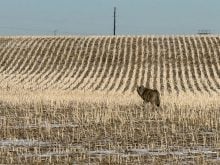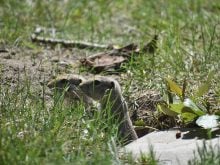COURVAL, Sask. – A gasoline engine belches blue smoke into the grey, cold air as it pumps muddy water from Gordon Anderson’s darkened basement. The water pours through black plastic hose onto plywood set in the farmyard mud. It will join more water flowing away from the farm where it has sat for three days, and return to the Wood River.
Anderson is reclaiming his farm from the flood.
Split by the force of flood water, a grain bin lies open. Wheat, spread like a giant golden pancake around the granary, swallows an old truck, other bins and augers.
Read Also

Agritechnica Day 2: The future of tractor power, building quicker crop apps and large farms and tech
Agritechnica Day 2: The future of tractor power, building quicker crop apps with Syngenta and large farms and tech
Nature has claimed more than $10,000 from Anderson.
The uninsured farm at a glance looks flat and muddy but relatively undamaged, other than the destroyed grain bin. Closer examination reveals that water has entered almost every piece of farm machinery, every building, every engine, every electric motor.
This is farming
“We’ll pump out, clean up and carry on. What else can you do? This is farming,” said Anderson, standing in the cold of his unlit farmhouse kitchen.
Unlike anything else in the collective generational memory, the flood of 1997 will live long in the lore of southwestern Saskatchewan’s farmers. Families here can recite the exact number of feet above sea level at which their houses sit. The few times this normally dry country has seen water at these levels have etched themselves on the residents’ memories.
The people of this region have built higher and better after each of the other floods, 1942, 1952 and 1976. Despite the dams, dikes, diversions and water controls, nature has risen above it all.
“A beaver on the doorstep and muskrat on the lawn. The water came right up to the house but it didn’t quite get in,” said Steve Wilson, a Coderre-area farmer. Wilson’s tractors and grain truck were gathered around the high ground surrounding his home that soon became an island the day before Easter.
That same day the Doll family, of Courval, knew it was time to leave their farm when giant sheets of ice sliced off their power poles, leaving them without electricity.
“The pumps were keeping up with the water until then. After that we knew it was over and we’d have to go,” said Edna Doll.
Neighbors showed up to help the Dolls move out. The town of Courval, population nine, is only a kilometre away via a bridge that still crossed the Wood River that day. Thirty-six people appeared to help the family pack and leave.
“We were packed and gone in three hours and fifteen minutes. The water was right behind us,” said Doll.
Cattle, 150 head, 32 pigs, hay and feed stocks were moved to higher ground before the bridge was washed away, separating the family from their farm. John, Edna and their three daughters moved to John’s uncle’s farm on the north side of the river. It is now a 60 kilometre drive to a farm they can see across the water.
“There is no insurance for floods. We will wait until the bridge is rebuilt. Whenever that will be. Hopefully there will be some disaster relief through the (rural municipality) and the province. We’ll clean up the mess and go home then,” said Doll.














